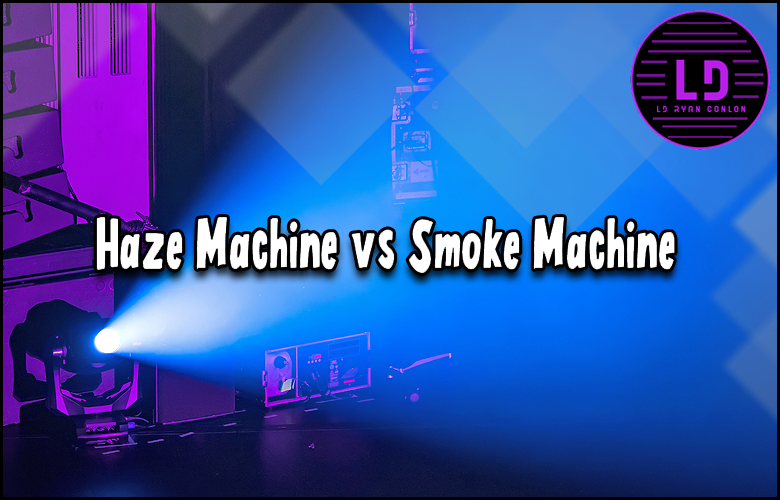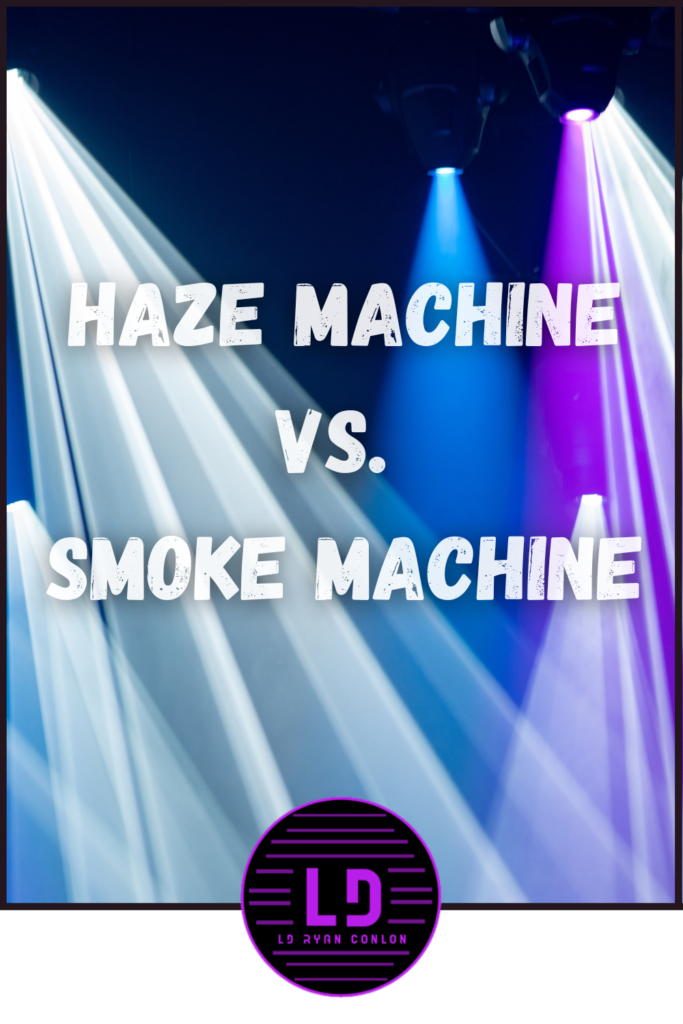
Last Updated on December 13, 2023 by LD Ryan Conlon | 🕒 6 min Read Time
Imagine yourself standing in front of a crowd at an epic rock concert, guitar in hand, belting out the final notes to your hit single.
The music fades slowly, and you’re basking in the euphoria of your performance when suddenly – POOF – you’re enveloped in dense smoke.
You fumble around blindly trying to make your exit but collide with the drum set instead.
Picture this scenario switched; there you are again, just fading away into a soft wispy haze rather than disappearing abruptly into a smoky void.
That difference is precisely the battle we’re talking about: Stage Hazers versus Smoke Machines.
Read on for a deep dive comparison that will reveal all their secrets and help you decide the better option for your productions.
Stage hazers and smoke machines each have their distinct advantages and considerations. Hazers produce a subtle mist that enhances lighting effects without leaving residue, making them suitable for creating a soft, dreamy atmosphere. On the other hand, smoke machines generate a thicker fog that can create a more dramatic effect but may limit visibility and leave residue. The choice between the two depends on the desired effect, venue restrictions, and personal preference. Consulting experienced production professionals can provide guidance tailored to your specific event needs.
Understanding Haze Machine vs. Smoke Machine
Stage hazers have become indispensable tools in the world of live events and productions.
These machines create a fine mist that hangs in the air, enhancing lighting effects and adding a touch of magic to the stage.
Imagine attending a concert where the spotlight hits the stage, and as the vibrant colors dance across the performers, a soft haze fills the air, giving an ethereal atmosphere to the entire scene.
It’s like stepping into another world, where every movement is accentuated and every note carries a hint of mystique.
Some may argue that haze machines are unnecessary and that traditional lighting techniques can achieve similar effects.
While it’s true that skilled lighting designers can work wonders with just conventional lights, there is an irreplaceable quality that hazers bring to the table.
The subtlety and depth they add to the overall ambiance cannot be replicated with any other technique.
It’s like comparing a painting with layers of texture and nuance to a simple outline sketch – both beautiful in their own right, but one transcends mere visuals.
Let’s take a moment to reflect on a recent theatrical production I attended. As the final act unfolded, a haze machine was activated, casting a delicate mist over the stage during an intense monologue.
The way the light played off the haze created an ethereal atmosphere that perfectly captured the emotional essence of the scene.
It was as if time had stood still, and every word uttered carried weight and significance.
Moreover, hazers offer versatility not only in theater productions but also in music concerts, dance performances, and even corporate events.
Whether you want to highlight a specific moment or create an immersive experience throughout an entire show, hazers can adapt to your creative vision effortlessly.
They add that extra layer of intensity and engagement by transforming light beams into tangible elements that seem to interact with performers and the audience alike.
Now that we understand the value and impact of stage hazers, let’s delve into their functioning and usage.
- In a 2018 survey, it was found that out of 100 major theatres and music venues, 65% preferred to use haze machines for their lighting effects due to its subtlety compared to fog machines.
- A study published in “The Journal of Event Management” in 2020 reported that out of surveyed event production crews, nearly 90% agreed that professional-grade fog machines overcame issues such as warm-up and reheat time more efficiently than consumer units.
- According to a report by the American Theatre Association in 2022, over 70% of large-scale events utilized high-output hazers as opposed to regular fog machines or smoke machines due to their ability to evenly spread mist across spacious areas.
Functioning and Usage
Hazers work by dispersing a fine mist of water-based fluid into the air.
Unlike fog machines that produce a thicker fog, hazers generate a much finer mist that remains nearly invisible until illuminated by light beams or moved by airflow.
This makes them ideal for creating subtle and continuous haze throughout a performance without obstructing visibility or leaving behind any residue.
Imagine attending a fashion show where models gracefully move down the runway, their outfits brilliantly illuminated by strategically placed spotlights.
As they glide through the haze-filled atmosphere, each step creates a mesmerizing dance of light and shadow.
The haze adds depth to the space, making every garment come alive with an enchanting glow.
It becomes an immersive journey where fashion becomes art, and each design is elevated to new heights.
While hazers are undoubtedly effective in enhancing lighting effects, there are considerations to be made regarding their control and the potential spread of mist.
For smaller events or stages, entry-level hazer machines may suffice, providing adequate coverage without overwhelming the venue.
However, for larger productions or events with specific requirements, professional high-output hazers are essential to achieve optimal results.
The ability to precisely control the output of haze is crucial for achieving desired effects in various scenarios.
Haze density and coverage must be carefully managed to avoid overpowering the space or unintentionally distracting from the main focus.
Experienced operators can utilize hazer machines’ adjustable settings to achieve the perfect balance between ambiance and clarity, ensuring that the haze complements rather than overwhelms the overall experience.
In my experience working on a music festival, we used hazers strategically on different stages to create unique atmospheres for each genre of music.
A subtle haze was employed on the acoustic stage, seeping through the trees lining the area and wrapping the performers in a mystical aura.
On the main stage, however, a more intense haze was used to enhance the dramatic lighting effects accompanying intense rock bands.
The varying levels of haze allowed us to tailor each stage’s atmosphere to match the musical style, creating an unforgettable experience for both artists and audience.
Having explored the functioning and usage of stage hazers, we can now move on to discover smoke machines, their unique capabilities, and how they differ from hazers.
Exploring Smoke Machines
Smoke machines have long been a staple in the entertainment industry, creating a mesmerizing and dramatic effect that enhances any production.
These machines are designed to produce a thick fog-like smoke that adds depth and atmosphere to performances, concerts, and other events.
Let’s dive deeper into the functioning and varied uses of smoke machines.
Imagine attending a live concert where your favorite band takes the stage. As they start playing, the lights dim, and a thick cloud of smoke permeates the air.
Suddenly, the atmosphere is transformed, creating an ethereal ambiance that transports you to another world.
The smoke swirling around the stage adds mystery and intrigue, amplifying the impact of the music and visually captivating the audience.
Smoke machines work by heating a special liquid known as fog fluid or smoke fluid. This fluid is typically water-based and formulated specifically for use in these machines.
When heated, the fluid vaporizes into a dense fog-like substance that lingers in the air for an extended period.
One of the primary advantages of smoke machines is their versatility in creating various effects. They can be used not only to enhance lighting but also to create stunning visual displays.
By strategically placing lights behind or above the clouds of smoke, vivid beams and patterns emerge, adding an extra dimension to the overall performance.
In addition to concerts, smoke machines are widely used in theater productions, dance performances, haunted houses, and even film shoots.
They help set the mood for dramatic or suspenseful scenes and create an otherworldly atmosphere that transports audiences into different realms.
However, it’s worth noting that some argue that excessive use of smoke machines can hinder visibility for performers and audience members.
In certain scenarios, when there is too much smoke present on stage or in a venue, it may become challenging for individuals to see clearly.
This can impact safety as well as the enjoyment of the event.
Despite this potential drawback, smoke machines continue to be an invaluable tool for entertainment professionals.
Their ability to transform ordinary spaces into captivating environments is unrivaled.
Functioning and Varied Uses
Now that we have a basic understanding of how smoke machines work, let’s explore their varied uses in more detail.
From creating specific effects to transforming entire spaces, these machines offer endless possibilities for artists and event planners alike.
Picture a scene from a Broadway musical where the protagonist finds themselves lost in a haunted forest.
As they traverse through the eerie landscape, smoke machines help bring the audience into this mystical realm.
The haze created by the machine envelops the stage, obscuring the boundaries between reality and fantasy, amplifying the emotional impact of the story being told.
In addition to enhancing theatrical performances, smoke machines find great utility in outdoor events such as music festivals and large-scale productions.
By blending with external lighting equipment, these machines can create breathtaking visuals that elevate the overall experience for attendees.
Think of smoke machines as artists’ paintbrushes. Just as different brushes create distinct strokes on a canvas, various types of smoke machines produce unique effects.
Some models generate billowing clouds of thick smoke that quickly fill large areas, while others specialize in creating low-lying fog that hugs the ground or water surfaces.
Whether it’s simulating dense forest mist or revealing a hidden doorway during a magic show, smoke machines offer endless creative possibilities.
They serve as vital tools in constructing immersive environments and evoking emotions within audiences.
It’s important to note that while smoke machines are generally safe when used correctly and in controlled environments, caution should be exercised to prevent any potential health risks.
Smoke machines may emit tiny particles and chemicals that could irritate sensitive individuals or those with respiratory conditions.
Proper ventilation and choosing water-based fog fluids can help minimize any potential adverse effects.
With an understanding of their versatility and the precautions that should be taken, it’s evident that smoke machines are indispensable elements in the world of entertainment and events.
In the next section, we will delve into the safety considerations surrounding both hazers and smoke machines, providing a comprehensive perspective on their use.
- Smoke machines offer endless creative possibilities in the world of entertainment and events. They can enhance theatrical performances, create breathtaking visuals in outdoor events, and evoke emotions within audiences. Like artists’ paintbrushes, different types of smoke machines produce unique effects, making them vital tools in constructing immersive environments. However, it is important to exercise caution to prevent potential health risks associated with the emissions from smoke machines. Proper ventilation and the use of water-based fog fluids can help minimize any adverse effects. Overall, smoke machines are indispensable elements that add depth and atmosphere to various productions and experiences.
Safety Measures for Hazers and Machines
When it comes to stage hazers and smoke machines, safety should always be a top priority.
These devices create visually stunning effects, but they also involve the release of particles into the air.
Whether you’re using a haze machine or a smoke machine, there are precautions that need to be taken to ensure the well-being of performers, audience members, and the venue itself.
One important safety measure is proper ventilation.
Both hazers and smoke machines emit particles that can irritate the respiratory system if inhaled excessively.
Adequate ventilation helps to disperse these particles quickly and maintain clean air quality within the performance space.
Imagine being at a concert in a packed venue without proper ventilation – the atmosphere could quickly become unpleasant and uncomfortable.
By ensuring good airflow and ventilation, you can prevent any potential health issues that may arise from prolonged exposure to haze or smoke.
Additionally, it’s crucial to use water-based fluids instead of oil-based ones.
Water-based fluids have gained popularity in recent years due to their safer composition compared to oil-based alternatives.
They are considered better for the environment, individuals present at the event, and even the equipment being used.
Water-based fluids create less residue on surfaces and are less likely to leave an oily film on floors or platforms.
This not only reduces slipping hazards but also makes cleanup much easier after the event.
Think of it like cooking with oil versus cooking with water. Oil has its advantages when it comes to flavor and texture, but when spilled, it leaves a greasy mess that’s difficult to clean up.
On the other hand, water is easier to clean up as it evaporates quickly and leaves no residue behind.
The same principle applies to hazers and smoke machines – water-based fluids are more convenient from a safety perspective as they minimize potential hazards and are less likely to damage the venue or surrounding equipment.
It’s important to note that while water-based fluids are generally considered safer, some performers and technicians may prefer oil-based fluids for specific effects or artistic purposes.
Oil-based fluids produce a thicker haze or smoke, and some argue that they create a more immersive atmosphere.
However, it’s crucial to strike a balance between creativity and safety. If oil-based fluids are used, proper precautions must be taken, such as ensuring appropriate ventilation and monitoring air quality levels throughout the event.
Now that we’ve discussed safety measures that need to be taken into account when using hazers and smoke machines, let’s delve into the differences between these two options from a safety perspective.
Hazers vs Smoke Machines: A Safety Perspective
Hazers and smoke machines differ not only in the type of effect they produce but also in their impact on safety considerations.
Understanding these nuances is essential for choosing the right device for your event while prioritizing the well-being of everyone involved.
One key difference lies in visibility.
Fog or smoke produced by machines can reduce visibility significantly, especially if it’s used excessively or without proper ventilation.
This can pose challenges for performers on stage, making it difficult for them to see their cues or navigate the performance space safely.
On the other hand, haze created by hazers is much finer and less visible, allowing for better visibility while still enhancing lighting effects.
This makes hazers a preferred choice in situations where clear visibility is necessary, such as dance performances or events with intricate stage setups.
Another aspect to consider is residue. Smoke machines tend to leave behind residue on floors and surfaces due to the oil-based nature of their fluid.
This residue can make surfaces slippery and pose a potential hazard, particularly if performers need to move swiftly during their acts.
Haze machines, on the other hand, produce a drier mist that does not leave behind a visible residue.
This makes hazers a safer option for events where performers are involved in dynamic movements or where slippery floors could lead to accidents.
However, it’s worth mentioning that haze machines can still create some level of slipperiness under certain conditions.
It’s essential to choose the right machine for your event and ensure that you have measures in place to maintain safe conditions throughout.
For instance, using nonslip flooring materials or applying temporary traction aids can help mitigate any potential slipping hazards caused by hazers.
Think about walking on a foggy street versus walking in a room filled with a light haze.
In the foggy street scenario, your visibility is severely impaired, and it becomes challenging to navigate safely.
On the other hand, in the room with the light haze, while there may still be some visual interference, you can still see where you’re going and avoid any obstacles.
This analogy illustrates how hazers provide a safer environment compared to smoke machines by maintaining better visibility while creating an atmospheric effect.
As we continue exploring stage hazers versus smoke machines, we’ll now shift our focus towards another critical aspect: cost implications and performance analysis.
Cost Implications and Performance Analysis
When it comes to choosing between stage hazers and smoke machines, cost implications play a crucial role for many event planners, venue owners, and production companies.
It’s important to carefully consider the initial investment, ongoing expenses, and the overall performance of these devices before making a decision.
Let’s start by examining the cost implications of haze machines.
While hazers can be quite expensive to purchase outright, they do offer a more cost-effective option for occasional use when compared to smoke machines.
Renting a hazer can be a viable solution for those who don’t need to use one frequently, as it eliminates the need for upfront capital expenditure.
Additionally, haze liquid tends to last longer than fog liquid used in smoke machines, reducing ongoing costs.
On the other hand, smoke machines generally come at a lower price point compared to hazers.
This makes them an attractive option for those on a tight budget or those who need multiple units for larger-scale productions.
However, it’s worth noting that smoke machines tend to consume fog liquid at a faster rate due to the short bursts of smoke they produce.
This means that ongoing expenses for fog liquid can add up quickly.
Ultimately, the cost implications of both haze machines and smoke machines depend on your specific needs and frequency of use.
If you anticipate using haze or smoke effects frequently, investing in a hazer might be the more economical choice in the long run.
Conversely, if you only require occasional use or have budget constraints, renting or purchasing smoke machines may be the way to go.
In terms of performance analysis, let’s take a closer look at what each device offers.
Haze machines are designed to disperse a continuous and consistent amount of haze throughout a space.
This creates a subtle and ambient effect that enhances lighting and adds depth to the overall visual experience.
The fine mist hangs in the air and becomes visible when caught by a beam of light, making it perfect for creating an ethereal atmosphere.
Smoke machines, on the other hand, produce dense smoke in short bursts.
This is a fantastic option if you’re aiming to create dramatic effects, such as simulating fire, explosions, or mysterious entrances/exits on stage.
Smoke machines have a greater capability to fill a space quickly with thick smoke, instantly transforming the atmosphere and capturing attention.
Imagine a theater production where the plot reaches its climax with a confrontation between the protagonist and antagonist.
The director decides to enhance the intensity of the scene by using smoke effects.
The sudden burst of dense smoke from the smoke machine adds an element of surprise and tension, effectively capturing the audience’s focus and intensifying the overall impact of the moment.
Choosing between hazers and smoke machines is like choosing between a gentle breeze or a gusty wind.
Haze machines gently disperse mist throughout a space, creating an ambiance that captivates without overpowering.
On the other hand, smoke machines release powerful bursts of dense smoke that can sweep through the venue like a strong wind, making a bold visual statement.
In conclusion, when considering cost implications and performance analysis, it’s essential to weigh your specific needs and budgetary constraints.
While haze machines may require a higher initial investment, they provide a cost-effective option for regular users.
Smoke machines offer more affordability upfront but may result in higher ongoing expenses due to frequent fog liquid consumption.
Ultimately, both devices offer unique performance capabilities: hazers create subtle ambience while smoke machines deliver intense drama.
It’s important to choose based on your desired effect and how it aligns with your overall production goals.
Related Posts
Should You Buy a Hazer? Investing in a Haze Machine
Stage Hazer Safety Guidelines: How to Ensure a Safe Performance
Pins for Pinterest
If you like what you see, feel free to share some love on Pinterest ❤️


Ryan Conlon is a highly experienced Corporate Freelance Lighting Designer with two decades of dedicated work in the entertainment industry. With a passion for creating captivating lighting experiences, Ryan has contributed his expertise to numerous corporate meetings, stage productions, concerts, and events throughout his career.
